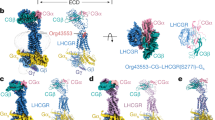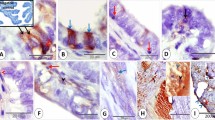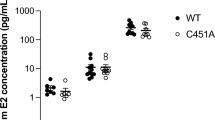Abstract
RECENT research (see refs. 1–3) has shown that 17β-oestradiol is specifically taken up and retained, without detectable chemical transformation, by uterus, vagina, adenohypophysis, mammary gland4 and hypothalamus5. In contrast, other organs rapidly release or transform it. In target tissues most of the hormone is found in the nuclear fraction—up to 80 per cent, depending on the homogenization conditions—and the rest is mostly in the 105,000g supernatant6–10. Toft and Gorsky11,12 found that the hormone in the supernatant is bound in larger part to a macromolecule (9.5S) which, at least in part, consists of protein and has the properties of a specific receptor for oestrogens, that is, it shows a high affinity and specificity for oestrogenic molecules.
This is a preview of subscription content, access via your institution
Access options
Subscribe to this journal
Receive 51 print issues and online access
$199.00 per year
only $3.90 per issue
Buy this article
- Purchase on Springer Link
- Instant access to full article PDF
Prices may be subject to local taxes which are calculated during checkout
Similar content being viewed by others
References
Jensen, E. V., in Biological Activities of Steroids in Relation to Cancer (edit. by Pincus, G., and Vollmer, E. P.), 161 (Academic Press, New York, 1960).
Jensen, E. V., in Rec. Prog. Hormone Res., 18, 387 (1962).
Jensen, E. V., in Canad. Cancer Conf., 6, 143 (1966).
Bresciani, F., and Puca, G. A., Atti IX Cong. Soc. Ital. Patol., 9, 653 (1965).
Eisenfeld, A. J., and Axelrod, J., Endocrinology, 79, 38 (1966).
Talwar, G. P., Segal, S. J., Evans, A., and Davidson, O. W., Proc. US Nat. Acad. Sci., 52, 1059 (1964).
Jensen, E. V., in Proc. Second Intern. Cong. Endocrinol., London, 1964, 420 (Excerpta Medica Foundation, Amsterdam).
Noteboom, W. D., and Gorski, J., Arch. Biochem. Biophys., 111, 559 (1965).
King, R. J. B., and Gordon, J., J. Endocrinol., 34, 431 (1966).
Puca, G. A., Orii, H., and Fragomele, F., Atti X Congr. Soc. Ital. Patol., 10 (in the press).
Toft, D., and Gorski, J., Proc. US Nat. Acad. Sci., 55, 1574 (1966).
Toft, D., Shyamala, G., and Gorski, J., Proc. US Nat. Acad. Sci., 57, 1740 (1967).
Jensen, E. V., Hurst, D. J., Desombre, E. R., and Jungblut, P. W., Science, 158, 385 (1967).
Sandberg, A. A., and Slaunwhite, jun., W. R., J. Clin. Invest., 36, 1266 (1957).
Duncan, G. W., Lyster, S. C., Clark, J. J., and Lednicer, D., Proc. Soc. Exp. Biol. (NY), 112, 439 (1963).
Author information
Authors and Affiliations
Rights and permissions
About this article
Cite this article
PUCA, G., BRESCIANI, F. Receptor Molecule for Oestrogens from Rat Uterus. Nature 218, 967–969 (1968). https://doi.org/10.1038/218967a0
Received:
Revised:
Issue Date:
DOI: https://doi.org/10.1038/218967a0
This article is cited by
-
The role of subcellular localization in assessing the cytotoxicity of iodine-125 labeled iododeoxyuridine, iodotamoxifen, and iodoantipyrine
Journal of Radioanalytical Chemistry (1981)
Comments
By submitting a comment you agree to abide by our Terms and Community Guidelines. If you find something abusive or that does not comply with our terms or guidelines please flag it as inappropriate.



